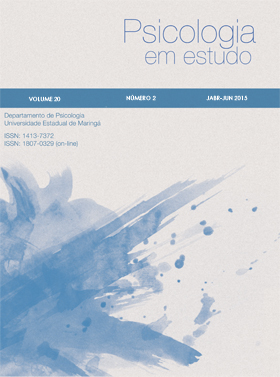COCHLEAR IMPLANT AND AUTISM SPECTRUM DISORDER: THE EXPERIENCE OF MOTHERS
Abstract
Cochlear implant (CI), a device surgically implanted in the ear, may be indicated for people with severe or profound hearing loss (HI). A significant number of children are affected by HI and other comorbidities, including Autism Spectrum Disorder (ASD). The objective of this study was to understand the experience of mothers of children with CI and diagnosis of ASD. The study had qualitative nature and the method used was phenomenological investigation, which consists in the apprehension of the phenomenon as it manifests itself to the person who experiences it. Six mothers of children with CI and diagnosis of ASD were interviewed. The statements were submitted to the process of phenomenological analysis and were unveiled in seven thematic categories: The impact of multiple disabilities; Exclusive dedication to the children; "Twenty-four hours running after it"; "The cochlear implant was a blessing in the life of both of us"; "It is as if he were speaking"; Need for psychosocial support; How they feel now. The mothers revealed how they are subjectively affected in their relationship with the child with CI and diagnosis of ASD, indicating negative impact on the quality of their life. The CI meant the possibility of the child to participate in the audible world and of they, as mother, to have more access to their world. Hope in the development of their child's speech becomes the inspiration to continue the trajectory. The need for supporting services aimed at parents, the importance of interdisciplinary teamwork and the encouragement of the support network are highlighted in the study.Downloads
References
American Psychiatric Association (2013). Diagnostic and statistical manual of mental disorders. Washington, DC.
Beers, A. N., McBoyle, M., Kakande, E. Dar Santos, R. C. (2014). Autism and peripheral hearing loss: a systematic review. International Journal of Pediatric Otorhinolaryngology, 78(2014), 96-101.
Bevilacqua, M. C., Moret, A. L. M. & Costa Filho, O. A. (2011). Conceituação e indicação do Implante Coclear. In Bevilacqua, M. C. et AL. Tratado de Audiologia (pp. 408-425). Santos Editora.
Cho, K. S. & Hong, E. J. (2012). A path analysis of the variables relatedto the quality of life of mothers with disabled children in Korea. Stress and Health, 29(2012), 229-239.
Daneshi, A. & Hassanzadeh, S. (2007). Cochlear implantation in prelingually deaf persons with additional disability, J. Laryngol. Otol. 121(7), 635–638.
Donaldson, A. I., Heavner, K. S. & Zwolan, T. A. (2004). Measuring Progress in Children With Autism Spectrum Disorder Who Have Cochlear Implants. Archives of otolaryngology - Head and neck surgery, 130(2004), 666-671.
Favero, M. A. (2005). Trajetória e sobrecarga emocional da família de crianças autistas: relatos maternos. Dissertação de mestrado não publicada, Curso de Pós-graduação em Psicologia, Universidade de São Paulo, São Paulo.
Fitzpatrick, E. M., Lambert, L., Whittingham, J. & Leblanc, E. (2014). Examination of characteristics and management of children with hearing loss and autism spectrum disorders. International Journal of Audiology, 53, 577-586.
Hwang, H. W & Na, Y. J. (2008). The effects of selected eco-systemic variables on the parenting stress of mothers with children with disabilities. The Journal of Child education, 17(3), 267-280.
Jure, R., Rapin, I., & Tuchman, R. (1991) Hearing-impaired autistic children. Dev. Med. Child Neurol., (33)12, 1062–1072.
Lachowska, M., Pastuska, A., Lukaszewicz-Moszynska, Z., Mikolajewska, L. & Niemczyk, K. (2016). Cochlear implantation in autistic children with profound sensorineural hearing loss. Brazilian Journal of Otorhinolaryngology
Martins, J. & Bicudo, M. A. V. (2005). A pesquisa qualitativa em psicologia: fundamentos e recursos básicos. São Paulo: Centauro.
Paula, C. C., Padoin, S. M. M., Terra, M. G., Souza, I. E. O. & Cabral, I. E. (2014). Modos de condução da entrevista em pesquisa fenomenológica: relato de experiência. Revista Brasileira de Enfermagem, 67(3), 468-472.
Perold, J. L. (2001). An investigation into the expectations of mothers of children with cochlear implants. Cochlear Implants International, 2(1), 39-58.
Rezende, F. P., Yamada, M. O. & Morettin, M. (2015). Grupo de apoio psicossocial: experiências de pais de crianças com implante coclear. Psicologia em Estudo, 20(3).
Roper, P., Arnold, B., & Monteiro, (2003). Co-occurrence of autism and deafness: diagnostic considerations, Austim, (7)3, 245–253.
Tharpe, A., Bess, F., Sladen, D., Schissel, H., Couch, S. & Schery, T. (2006). Auditory characteristics of children with autism, Ear Hear. 27(4), 430–441.
Vernon, M. & Rhodes, A. (2009). Deafnes and autistc spectrum disorders. American Annals of the Deaf, 154(1), 5-14.
Wiley, S., Gustafson, S. & Rozniak, J. (2014). Needs of parents of children who are deaf/hard of hearing with autism spectrum disorder. Journal of Deaf Studies and Deaf Education, 19(1), 40-49.
Yamada, M. O. & Valle, E. R. M. (2014). Vivência de mães na trajetória de seus filhos com implante coclear: fatores afetivos emocionais. Ribeirão Preto: BookToy.
As opiniões emitidas, são de exclusiva responsabilidade do(s) autor(es). Ao submeterem o manuscrito ao Conselho Editorial de Psicologia em Estudo, o(s) autor(es) assume(m) a responsabilidade de não ter previamente publicado ou submetido o mesmo manuscrito por outro periódico. Em caso de autoria múltipla, o manuscrito deve vir acompanhado de autorização assinada por todos os autores. Artigos aceitos para publicação passam a ser propriedade da revista, podendo ser remixados e reaproveitados conforme prevê a licença Creative Commons CC-BY.
The opinions expressed are the sole responsibility of the author (s). When submitting the manuscript to the Editorial Board of Study Psychology, the author (s) assumes responsibility for not having previously published or submitted the same manuscript by another journal. In case of multiple authorship, the manuscript must be accompanied by an authorization signed by all authors. Articles accepted for publication become the property of the journal, and can be remixed and reused as provided for in theby a license Creative Commons CC-BY.
















